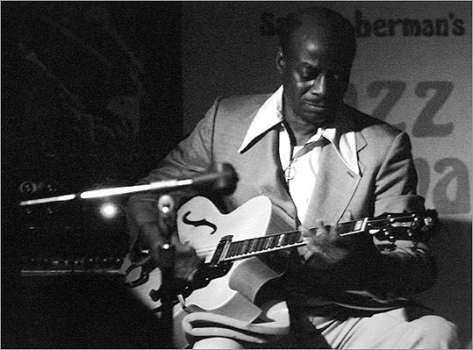In the 1950s, musicians who could play jazz, blues and R&B increased their income considerably. Guitarist Tiny Grimes was one of those who could switch around depending on the recording and touring opportunity.
For much of the early and mid-1950s, Grimes was on the road extensively fronting an R&B group called Tiny Grimes and His Rocking Highlanders. In 1957 and ’58, the blues went through a revival of sorts as rock ‘n’ roll grew increasingly popular. In ’58, Chuck Berry, Big Maybelle, Big Joe Turner and other blues players and singers appeared at the Newport Jazz Festival and at blues festivals. [Photo above of Tiny Grimes in the late 1940s by William P. Gottlieb]
The blues activity gave Bob Weinstock of Prestige an idea. Why not combine jazz artists with R&B players on jazz-blues recording sessions? The constant for this experiment would be Tiny Grimes, who had been greatly influenced by Charlie Christian. Grimes had come up in the 1940s as a member of The Cats and a Fiddle and with Art Tatum, Ike Quebec, Charlie Parker, the Three Riffs, Cozy Cole, Billie Holiday and Buck Clayton before leading his Rocking Highlanders.
The first Grimes blues-jazz fusion date was Blues Groove: Tiny Grimes & Coleman Hawkins Swingtet, recorded in February ’58. The group featured Musa Kaleem (fl), Coleman Hawkins (ts), Ray Bryant (p), Grimes (g), Earl Wormack (b) and Teagle Fleming (d).
Next up was Callin’ the Blues: Tiny Grimes Swingtet With J.C. Higginbotham in July ’58, featuring J.C. Higginbotham (tb), Eddie “Lockjaw” Davis (ts), Ray Bryant (p), Grimes (g), Wendell Marshall (b) and Osie Johnson (d).
A band session was next in August ’58 called The Prestige Blues Swingers: Outskirts of Town, featuring Art Farmer and Idrees Sulieman (tp), Buster Cooper (tb), Jerome Richardson (fl,as), Jimmy Forrest (ts), Pepper Adams (bar), Ray Bryant (p), Grimes (g), Wendell Marshall (b) and Osie Johnson (d), a session arranged by Jerry Valentine.
Hawk Eyes, led by Coleman Hawkins, was next. Recorded in April 1959, the date included Charlie Shavers (tp), Coleman Hawkins (ts), Ray Bryant (p), Tiny Grimes (g), George Duvivier (b) and Osie Johnson (d). The last of these Prestige blues-jazz dates with Grimes was Tiny in Swingville: Tiny Grimes Quintet With Jerome Richardson, featuring Jerome Richardson (bar, ts, fl), Ray Bryant (p), Grimes (g), Wendell Marshall (b) and Art Taylor (d).
All of these albums are excellent, and Grimes on his four-string guitar is a delight throughout. The recordings make you realize that among talented R&B and jazz players, the music was largely interchangeable. They didn’t view the music as incongruous, the way many listeners did, nor did jazz musicians look down on R&B as simple-minded music. They viewed it as an extension of Black culture with a different feel. What’s more, many jazz musicians received their first breaks in R&B bands and admired the genre and enjoyed playing it. Knockout tracks include Marchin’ Along, Blue Tiny, Annie Laurie and Jelly Jelly.
Marchin’ Along from Tiny Grimes With Coleman Hawkins…
Blue Tiny from Callin’ the Blues, with a killer Lockjaw Davis solo…
Annie Laurie, from Tiny Grimes with Jerome Richardson…
Grimes in a short in 1945 on Never Too Old to Swing…






More Stories
CD review: George Benson – Dreams Do Come True: When George Benson Meets Robert Farnon – 2024: Video, CD cover
The band was tight as ever. The Warren Haynes Band cuts loose: Video, Photos
Interview with Alvin Queen: Feeling Good – I heard these tunes played by … Video, new CD cover, Photos